15 Climbing Roses Perfect for Every Garden and Climate
Climbing roses are popular plants that add beauty and height to gardens. They can cover fences, walls, or trellises with colorful flowers and greenery. Many varieties are known for growing quickly and blooming for long periods, making them a practical choice for gardeners.
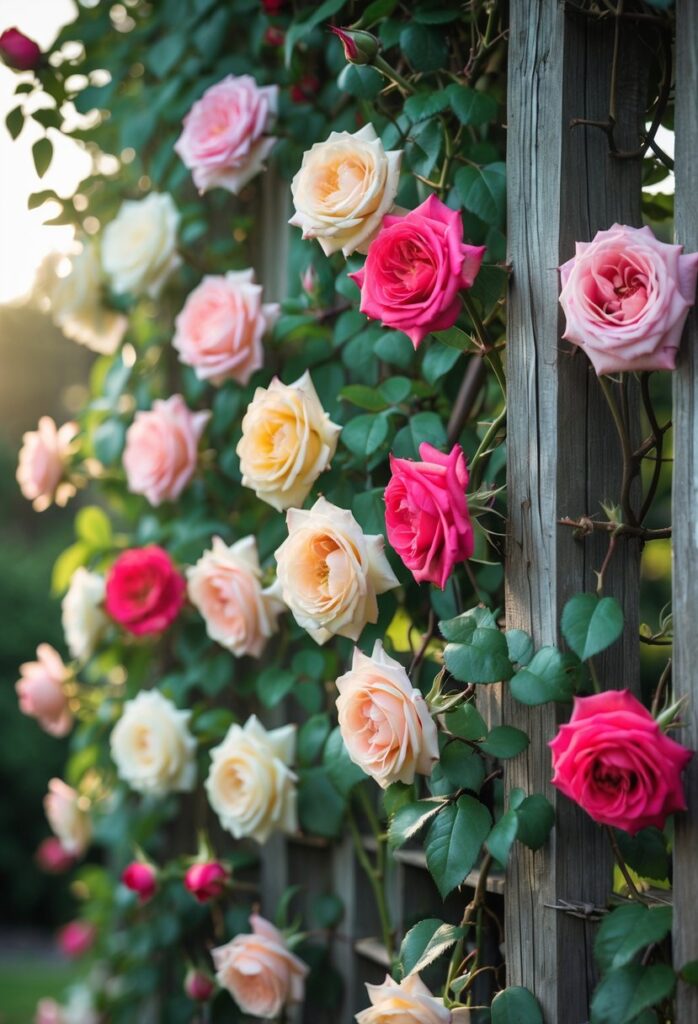
Climbing roses bring both visual appeal and functional use, making them a great addition to different garden styles. They come in many colors and types, some with fragrant blooms, and others that resist diseases and pests. This article highlights 15 climbing roses that can enhance any garden space.
1) Iceberg Climbing Rose
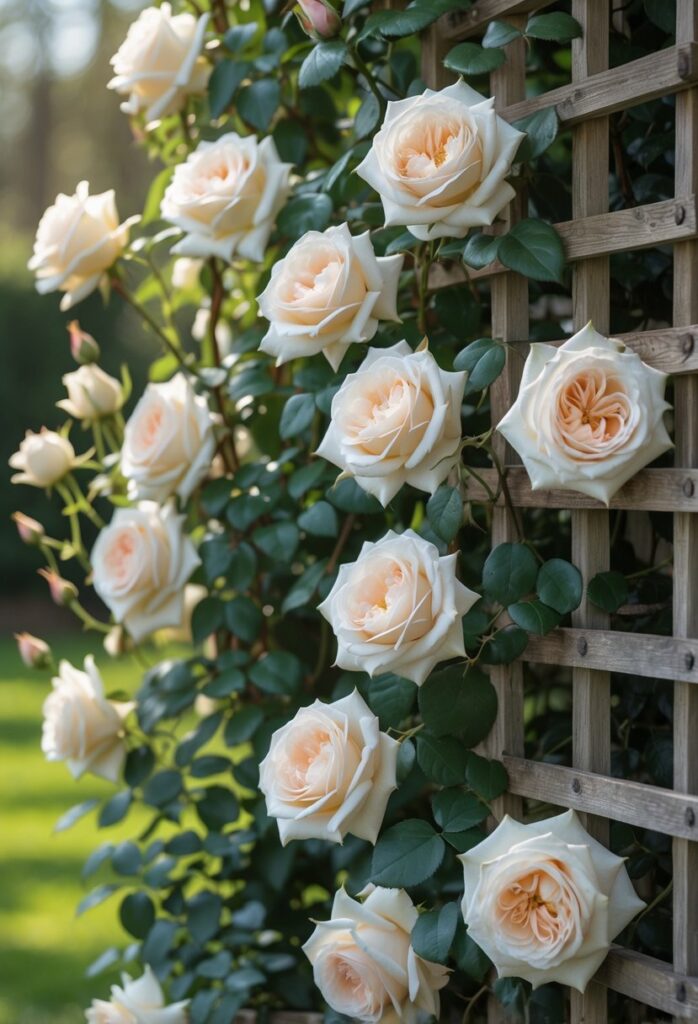
The Iceberg Climbing Rose is a popular climbing variety known for its clean, white flowers. It produces medium-sized, semi-double blooms that often appear in large clusters. The flowers have a light, sweet fragrance that adds a gentle scent to gardens.
This rose grows vigorously and can reach heights of 12 to 15 feet. It is well suited for training on trellises, arches, or pergolas. The plant blooms repeatedly from late spring through fall, offering a long season of color.
The Iceberg Climbing Rose is a natural mutation of the well-known Iceberg shrub rose. It thrives in a variety of climates and shows good disease resistance. It flowers mostly on old wood, so pruning should be done carefully to encourage new growth.
Its bright white blooms sometimes display a soft pink blush in cooler weather. Overall, it is a reliable and versatile climber that fits well in many garden designs.
2) Eden Rose (Pierre de Ronsard)

The Eden Rose, also known as Pierre de Ronsard, is a popular climbing rose. It was bred in France and introduced in 1985. This rose is known for its large, old-fashioned blooms that open from light green buds.
The flower colors start as creamy white with soft pink centers. The blooms are cup-shaped and have many petals, often up to 70. It grows vigorously on strong canes that can reach 12 to 15 feet tall.
This rose can be trained on fences, trellises, walls, or gazebos, making it a versatile choice for many gardens. It blooms repeatedly throughout the growing season, adding lasting color.
The Eden Rose is valued for both its beauty and its strong growth. Its glossy green foliage creates an attractive backdrop for the flowers. It has a light, pleasant scent which adds to its charm in any garden setting.
3) New Dawn Climbing Rose
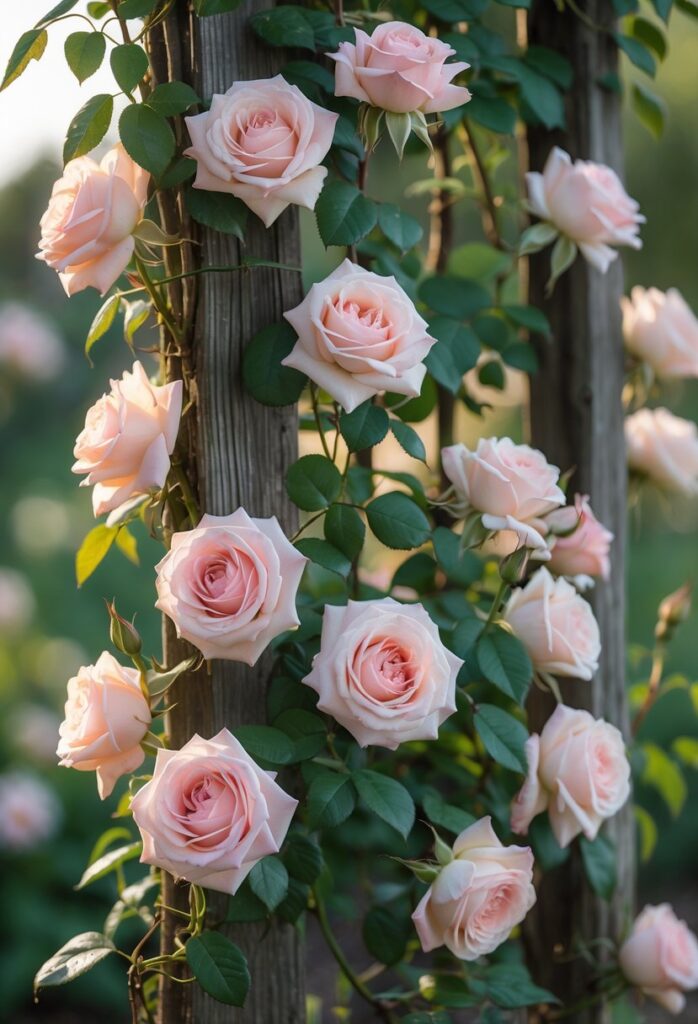
The New Dawn Climbing Rose is a popular choice for many gardeners. It has soft pink blooms that appear in clusters starting in late spring. The flowers are lightly fragrant and bloom repeatedly through the summer and fall.
This rose is known for its strong growth and ability to thrive in different conditions. It grows well in full sun to part shade and prefers moist, well-drained soil. It is also fairly disease-resistant, which makes it easier to care for.
New Dawn climbs well on trellises, fences, or walls. It blooms on both old and new wood, giving it a long flowering season. The plant can handle cold weather, suitable for growing in USDA zone 5 and warmer.
Its green foliage stays glossy and healthy, adding to its appeal even when not in bloom. This climbing rose also produces rosehips in the fall, giving it visual interest late in the season. It remains a trusted and classic climbing rose in many gardens.
4) Don Juan Climbing Rose

The Don Juan Climbing Rose is known for its large, dark red blooms and strong fragrance. The flowers are full and velvety, measuring up to 4-5 inches across, and bloom repeatedly from early summer through the season.
This rose grows vigorously, reaching heights of 12 to 14 feet with a spread of about 4 feet. It does well on trellises, arbors, or fences, making it a good choice for adding vertical interest to a garden.
Don Juan prefers full sun, ideally at least six hours daily, with morning sun being the best. Its foliage is glossy and dark green, which creates a nice contrast with the bright flowers.
Watering should be moderate but increased during dry periods. Fertilizing every four weeks in spring and summer with a balanced rose fertilizer helps encourage more blooms.
Pruning is important to promote healthy growth and keep the plant neat. It blooms on both new and old wood, which makes pruning easier and supports a long blooming season.
5) Cécile Brünner Climbing Rose
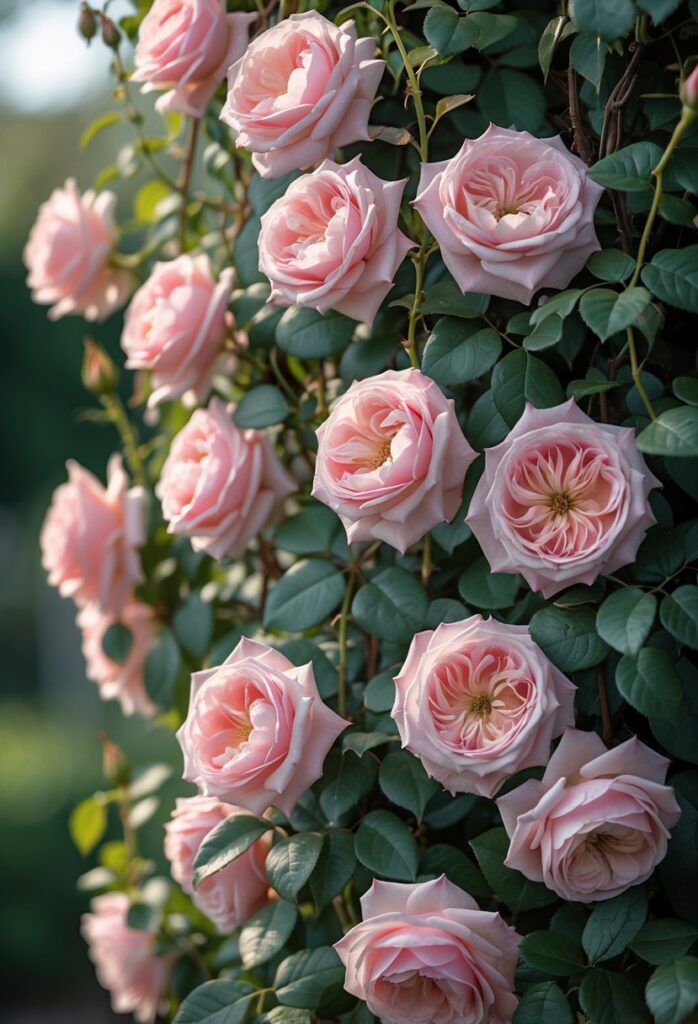
The Cécile Brünner Climbing Rose is a popular and classic climbing rose. It features small, pale pink flowers that bloom in clusters. These blooms are fragrant and have a soft, delicate appearance.
This rose grows vigorously and can reach heights of 20 to 30 feet. It works well on trellises, arbors, or fences. Its almost thornless stems make it easier to handle compared to other climbing roses.
It blooms from late spring until frost, producing flowers continuously. The foliage is dark green, providing a nice backdrop for the light pink flowers. The plant prefers full sun to partial shade and well-drained soil.
Cécile Brünner is also known for its hardiness and ability to tolerate different climates. It is an excellent choice for gardeners seeking a reliable and beautiful climbing rose.
6) Blaze Climbing Rose
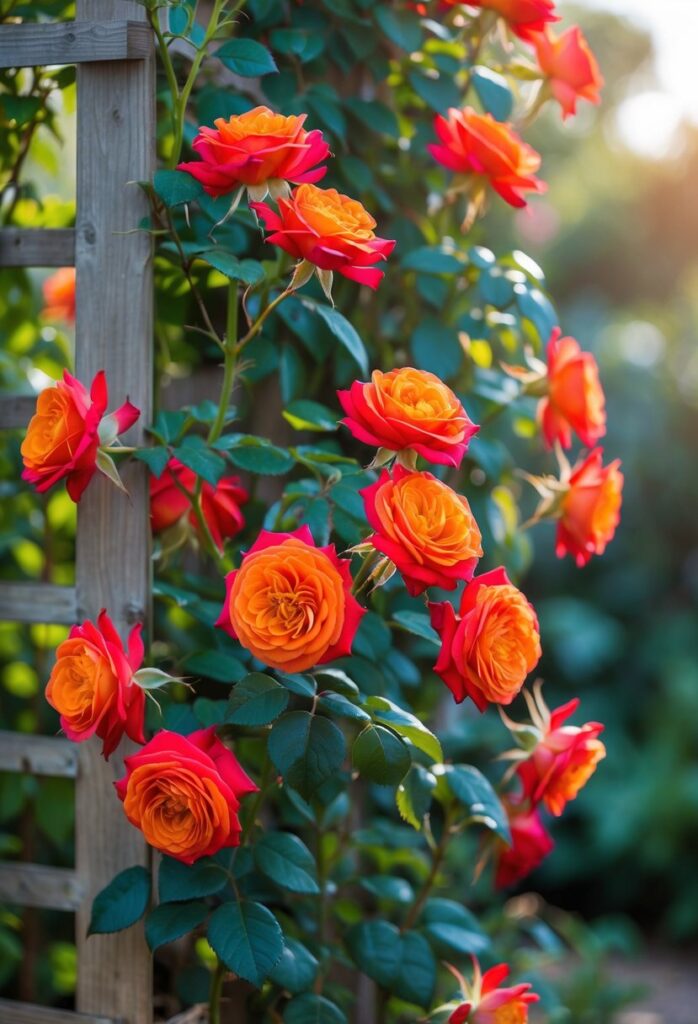
The Blaze Climbing Rose is known for its bright red, semi-double blooms. It produces flowers continuously from early summer through fall, providing long-lasting color. The clusters of flowers are about 2 to 3 inches wide.
This rose grows quickly and can reach heights between 10 and 15 feet. It is easy to train on trellises, walls, or arbors. Its vigorous growth helps cover large garden spaces.
Blaze Climbing Rose blooms on both new and old wood. This trait allows it to flower for many months. It is also hardy in cold temperatures, surviving down to -30°F.
It has a slight fragrance and spreads well, making it suitable for transforming vertical areas. The rose is popular because it combines strong growth with appealing, abundant blooms.
7) Zephirine Drouhin
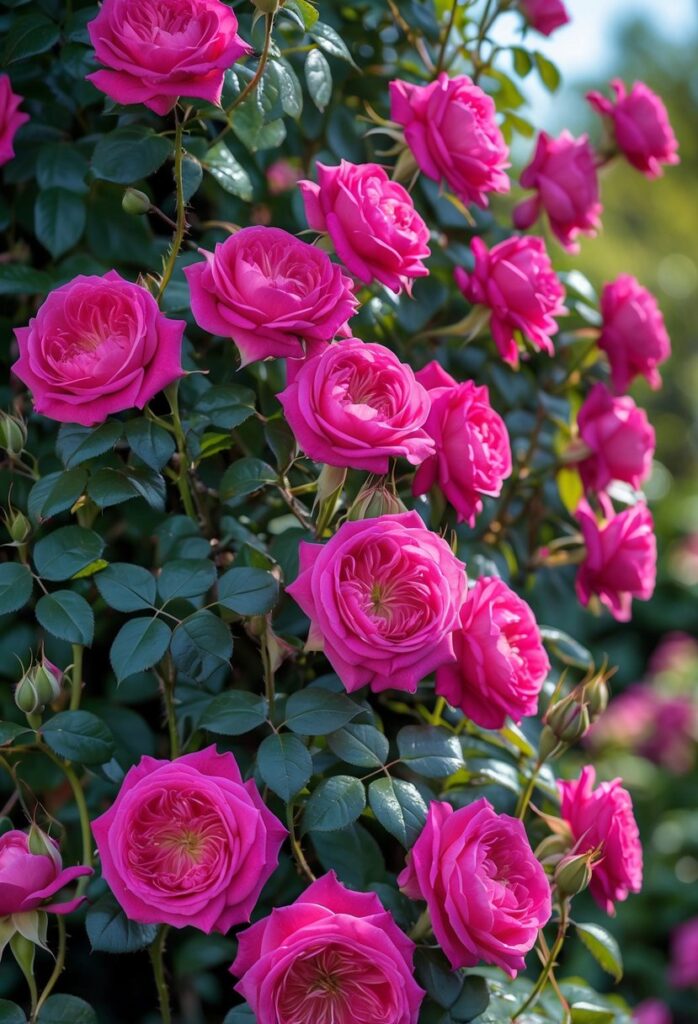
Zephirine Drouhin is a climbing rose known for its strong fragrance and smooth, nearly thornless stems. It produces double-pink flowers that bloom in clusters, adding charm and color to gardens.
This rose can grow 15 to 20 feet tall. It works well on walls, fences, or trellises. It is also easy to prune, making it suitable for both beginners and experienced gardeners.
Its smooth, thornless canes make handling safer, especially in busy garden areas or where children play. The rose shows good resistance to diseases and needs minimal maintenance.
It tolerates some shade and poor soil, which adds to its appeal. Zephirine Drouhin is a versatile choice, often grown as a climber but can also be pruned as a shrub or used in hedges.
8) Golden Showers Climbing Rose

Golden Showers is a climbing rose known for its bright yellow blooms. It produces semi-double flowers that bloom continuously from early summer to mid-autumn. The flowers start as a rich golden yellow and fade to pale lemon or cream as they age.
This rose grows vigorously and can reach up to 8 feet tall. It has nearly thornless stems, which makes it easier to handle. The plant’s glossy green leaves create a nice contrast with the yellow flowers.
Golden Showers is prized for its long flowering season. It blooms on both old and new wood, allowing it to bloom repeatedly. The rose is also lightly scented, with a pleasant honey-like fragrance.
It adapts well to many climates and prefers a sunny spot. It is a good choice for trellises, walls, or arches. Deadheading spent flowers encourages more blooms, but leaving some can create colorful hips later in the season.
9) Climbing Pinkie Rose

Climbing Pinkie is a popular climbing rose known for its nearly thornless canes. This makes it easy to train on structures like trellises, arbors, and fences. It can grow 8 to 12 feet tall as a climber or be shaped into a large shrub.
The flowers are medium pink with semi-double petals. They bloom in clusters repeatedly from spring to fall. The rose has a mild fragrance and is valued for its long flowering season.
This rose grows well in hardiness zones 6 to 10. It prefers full to mostly sunny locations and needs moderate soil fertility. Climbing Pinkie is also quite disease-resistant and can tolerate saline irrigation when watered properly.
It can be used in many garden settings such as covering walls or creating informal hedges. Its cascading habit adds a soft, decorative effect. Gardeners appreciate it for both its appearance and ease of care.
10) Veilchenblau

Veilchenblau is a climbing rose known for its deep purple flowers that gradually turn to a mauve-blue shade. It was developed by Johann Christoph Schmidt in Germany around 1909. The flowers are semi-double and have a light, sweet fragrance.
This rose grows between 10 and 15 feet tall. It is vigorous and nearly thornless, making it easier to handle than many other climbing roses. Veilchenblau works well on walls, fences, or trained through trees.
It is hardy in USDA zones 5 to 9 and can tolerate some shade. The foliage is glossy and disease resistant. In the fall, it produces small brown-red hips that add interest to the garden.
Veilchenblau prefers well-draining soil and full sun but can manage in semi-shaded spots. Regular pruning helps keep its shape and encourages healthy growth. This rose is generally low maintenance and adds color over spring and early summer.
11) Fourth of July Climbing Rose
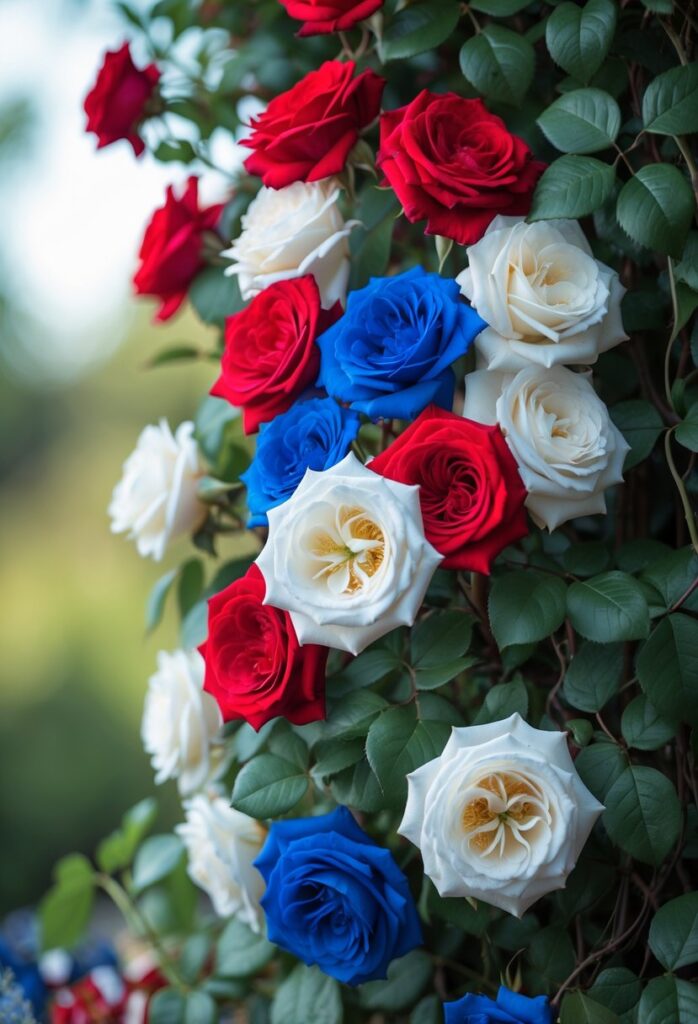
The Fourth of July Climbing Rose is known for its vibrant red and white striped flowers. It blooms continuously during the summer, providing a long season of color in the garden. This rose can grow between 10 and 14 feet tall, making it ideal for covering walls, trellises, or fences.
It is a hardy plant with disease resistance, which helps it thrive in various climates. The foliage is deep green and dense, adding to its visual appeal even when not in bloom. This climbing rose was created by Tom Carruth and won the All-American Rose Selection award.
Gardeners appreciate the Fourth of July for its strong growth and reliability. It can be planted on its own roots, which tends to increase its bloom production and hardiness over time. This rose works well paired with other climbing plants, like clematis, for a fuller landscape design.
12) Crepuscule Climbing Rose
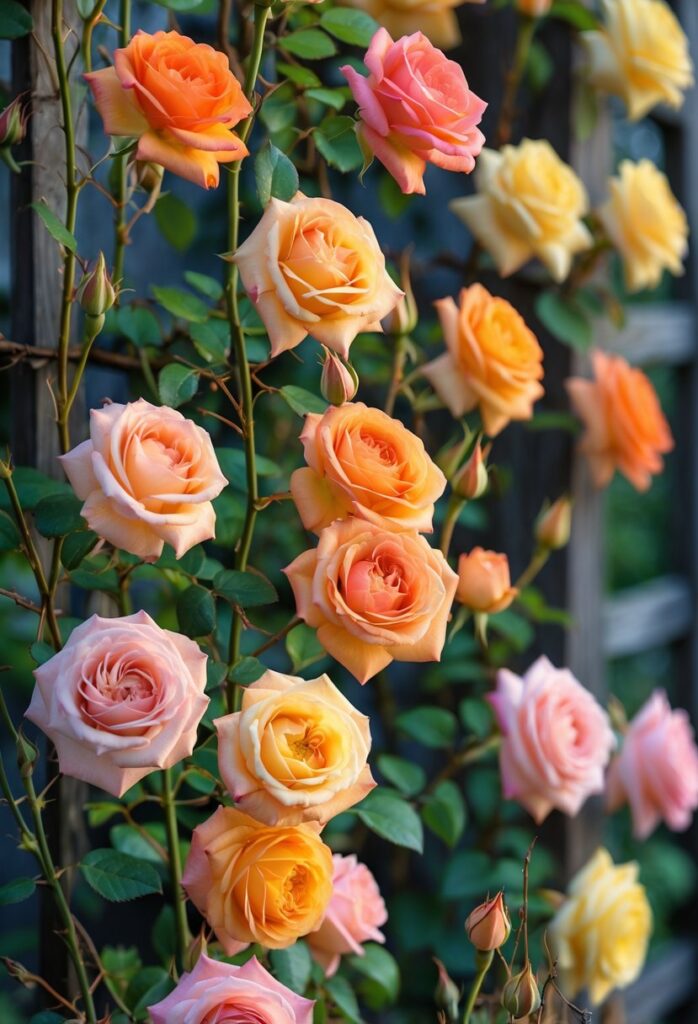
The Crepuscule Climbing Rose is known for its apricot-yellow flowers that appear in small clusters. The blooms start with a soft orange color and fade to a rich apricot shade. It has a light fragrance that adds a pleasant touch to gardens.
This rose grows tall, reaching about 12 to 15 feet. It has dark canes with almost no thorns, making it easier to handle. The leaves are dark green with a bronze tint and usually stay on through much of the winter.
Crepuscule is a strong grower and repeats its blooming well from late spring to autumn. It is resistant to many diseases, which makes it a reliable choice for many gardeners. It works well on fences, pergolas, and arches.
This variety is part of the Noisette rose family and was bred in 1904. It adapts best to warmer climates but can thrive in other areas with some care. Overall, it is a versatile climbing rose with a classic look.
13) John Cabot Climbing Rose
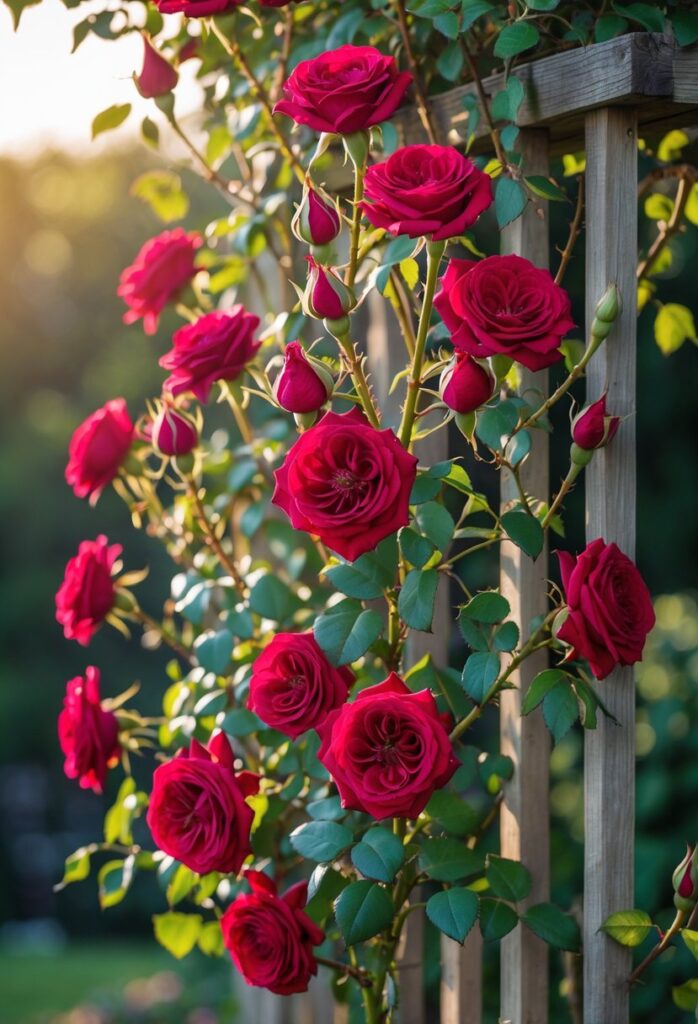
The John Cabot Climbing Rose is a hardy variety developed in Canada. It is known for its strong growth and ability to thrive in cold climates. This rose can grow between 5 and 8 feet tall, making it suitable for walls, trellises, and fences.
It produces clusters of double flowers that start deep red and fade to bright pink. The blooms are lightly scented and appear mainly in early summer, with some repeat flowering in the fall.
This rose is resistant to common diseases like black spot and powdery mildew. Its glossy green leaves add to its appeal and help protect its health. The John Cabot is favored by gardeners for its ease of care and reliable bloom.
Because of its toughness and beauty, it is often used in landscaping for mass planting or as a feature climbing rose. It needs full sun and well-drained soil to perform best. Regular watering and pruning can help maintain its shape and encourage more flowers.
14) Morning Jewel Climbing Rose

The Morning Jewel Climbing Rose is a vigorous rose that can grow up to 8 to 10 feet tall. It produces clusters of bright pink, semi-double flowers with a medium fragrance. The blooms have firm petals and last well when cut.
This rose has glossy, mid-green foliage that contrasts nicely with the flowers. It repeats flowering from summer through autumn, providing color for many months. The plant is hardy and adapts well to many types of locations, including walls, fences, and trellises.
Morning Jewel is grown on its own roots, which helps it stay true to its variety and makes it more resistant to disease. It can grow in different light conditions, including north, south, east, or west-facing spots. This rose is known for being reliable and rewarding for gardeners of all levels.
15) Rosa Banksiae (Lady Banks’ Rose)
Rosa Banksiae, commonly known as Lady Banks’ Rose, is a thornless climbing rose native to China. It grows quickly and can reach heights of up to 20 to 40 feet. Its delicate, small blooms come mostly in pale yellow or white and appear in large clusters in spring.
This rose thrives in USDA zones 6 to 11. In warmer zones, it stays evergreen, while in cooler areas it may lose its leaves during winter. It grows well in full sun or partial shade and has dense, green foliage.
Lady Banks’ Rose is valued for its low maintenance and vigorous growth. It climbs using flexible, thornless stems that make it easy to train on fences or trellises. It also shows good resistance to common rose diseases.
This plant requires minimal pruning, mainly to control size after blooming. Gardeners often choose it to add graceful, natural beauty to large spaces or walls. Its gentle blooms and ease of care make it a popular choice for many climbers.
How to Grow and Care for Climbing Roses
Climbing roses need the right soil, position, water, food, and pruning to thrive. Their growth depends on steady care and proper training to create strong, healthy plants with many blooms.
Soil and Location Requirements
Climbing roses do best in well-drained soil rich in organic matter. They prefer soil with a pH between 6.0 and 6.5. Adding compost or aged manure can improve soil fertility and texture.
Choose a sunny spot that gets at least six hours of direct sunlight daily. Avoid areas with strong winds or heavy shade. Good air circulation helps prevent diseases.
Plant roses where their roots won’t stay soggy. If water gathers, it can cause root rot. Spaces between plants should allow for growth and airflow, usually about 3 to 5 feet apart.
Watering and Feeding Guidelines
Regular watering is crucial for climbing roses, especially in dry spells. They need about 1 inch of water per week. Water deeply at the base to keep leaves dry and avoid fungal diseases.
Feed roses with a balanced fertilizer in early spring and again after the first bloom. Use products high in phosphorus for better flowering. Liquid or slow-release fertilizers both work well.
Mulching around the plant helps retain soil moisture and reduce weeds. Keep mulch a few inches away from the stem to prevent pests and rot.
Pruning and Training Techniques
Pruning climbing roses encourages new growth and more flowers. Prune in late winter or early spring before new shoots start. Remove dead, weak, or crossing branches.
Train main canes horizontally along a support to promote side shoots with flowers. Use garden ties or soft twine to avoid damaging stems.
Tie new growth gently and spread branches evenly. This increases sunlight exposure and improves air flow, reducing disease risks. Remove old wood after several years to keep the plant healthy.
Design Ideas for Climbing Roses
Climbing roses can add height and beauty to a garden by growing vertically and blending well with other plants. Choosing the right support and pairing them carefully with companion plants helps create a balanced and attractive garden space.
Creating Vertical Accents
Climbing roses work well to create vertical accents on walls, fences, trellises, or archways. These structures support their long canes and help display the flowers fully. Trellises can be simple wooden panels or metal frameworks, depending on the garden’s style.
Position climbing roses where they get at least six hours of sunlight. Regular pruning is necessary to keep the growth neat and encourages more blooms. They can frame doorways or gates, drawing the eye upward and adding dimension to flat garden areas.
Combining with Companion Plants
Companion plants provide color contrast, texture, and even pest control near climbing roses. Low-growing shrubs or perennials like lavender and catmint work well. These plants also prevent weeds and fill gaps at the base of climbing roses.
Choosing plants with similar water and sunlight needs improves success. Avoid plants that might compete too much for nutrients or space. This mix makes the rose display richer and reduces maintenance while creating a natural, layered look.
Frequently Asked Questions
Climbing roses vary in bloom patterns, growth habits, and care needs. Knowing which types bloom continuously, their mature sizes, and where to purchase them helps gardeners plan effectively. Proper care is key to keeping roses healthy and vigorous, especially varieties like ‘New Dawn’ and ‘Don Juan.’
What are the best types of climbing roses for continuous blooming?
Roses like ‘Iceberg Climbing Rose’ and ‘New Dawn’ are known for blooming repeatedly throughout the growing season. They offer many flowers from spring through fall with proper pruning and feeding.
How do you care for ‘New Dawn’ and ‘Don Juan’ climbing roses?
‘New Dawn’ thrives with regular watering and partial sun. It responds well to annual pruning after flowering to encourage new growth. ‘Don Juan’ prefers full sun and well-drained soil. Both need support and tying to prevent breakage.
What are the expected heights for mature climbing roses?
Most climbing roses grow between 8 to 15 feet tall. Some varieties, like ‘Eden Rose (Pierre de Ronsard),’ can reach up to 20 feet if properly trained and supported.
Where can one find climbing roses for sale?
Climbing roses are available at local nurseries, garden centers, and reputable online plant retailers. Specialty rose growers often offer popular varieties including ‘Cécile Brünner’ and ‘New Dawn.’
What care tips ensure the healthiest growth for climbing roses?
They need well-drained soil and consistent watering, especially in dry periods. Feeding with balanced fertilizer in spring and summer supports blooming. Regular pruning and tying new shoots help maintain shape and air circulation.
What are the easiest climbing roses for beginners to grow?
‘Iceberg Climbing Rose’ and ‘Cécile Brünner’ are often recommended for beginners. They are hardy, bloom well with basic care, and resist common diseases better than some other varieties.
